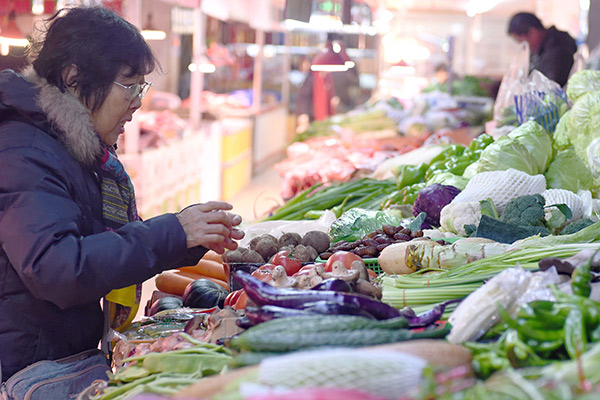
Vegetables are sold at a food market in Changchun, Jilin province, on Feb 10, 2017. [Photo/Xinhua]
BEIJING — China’s producer prices rose faster than expected in January while consumer inflation quickened, reinforcing views that economic growth is firming up and putting the central bank’s policy moves in focus.
The producer price index (PPI), which measures costs of goods at the factory gate, jumped 6.9 percent year on year last month, beating market expectations of 6.5 percent and marking a five-year high, according to the National Bureau of Statistics (NBS) on Feb 14.
The jump was mainly driven by the carry-over effect of last year’s price changes and rising prices of raw materials and oil and gas in the global market, according to NBS senior statistician Sheng Guoqing.
Factory-gate prices in the oil and gas extraction industry surged by 58.5 percent during the month, followed by a 38.4 percent gain in coal mining.
On a month-on-month basis, PPI edged up 0.8 percent.
While surging commodity prices were a major contributor for the strong rally, the data also pointed to improving domestic demand as China’s economy gradually gained strength.
Earlier official data showed China’s manufacturing sector has expanded for the sixth month in a row in January, while exports and imports saw a strong rebound.
The PPI has stayed in positive territory since September, when it ended a four-year streak of declines thanks in part to the government’s successful campaign to cut industrial overcapacity.
“China’s factory reflation is real and a more robust economy is contributing, but with the torrid pace of PPI increases tied to the commodity rally, the outlook for sustained rises is uncertain,” noted Tom Orlik, chief Asia Economist at Bloomberg.
For China’s economy as a whole, the PPI data offered a broad positive as rising prices could boost corporate profits and help contain financial risks.
The data released on Feb 14 also showed the consumer price index (CPI) grew 2.5 percent year on year last month, fractionally above market expectations of 2.4 percent.
The pace quickened from the 2.1 percent rise in December as the Lunar New Year Holiday pushed up food, transport and travel expenses, according to Sheng.
Food prices, which account for about one-third of China’s CPI, went up 2.7 percent, while nonfood prices increased 2.5 percent.
On a monthly basis, consumer prices went up 1 percent.
Orlik reckons consumer inflation pressure in China will remain moderate, but the rising trend will get close attention from the People’s Bank of China.
Wen Bin, an analyst at China Minsheng Banking Corporation, also warned of possible inflationary pressure from the strong PPI growth, predicting a tightening in the central bank’s monetary policy.
The central bank has already started to guide market rates higher. In open market operations earlier this month, it raised the lending rates to banks by 10 basis points, a move widely interpreted as a shift toward a more neutral monetary policy as economic fundamentals improved.
China’s monetary policy in 2017 is set to be “prudent and neutral” to keep appropriate liquidity levels and avoid large injections.
“The central bank is likely to continue on that path in the months ahead, as policy makers lean against excess leverage, yuan weakness and capital outflows, and nascent inflationary pressure,” Orlik wrote.
But economists largely ruled out more drastic moves such as benchmark interest rate hikes in the near future amid lingering concerns about the growth outlook. Instead, policymakers will be more likely to continue its use of open market operations and other targeted instruments to adjust liquidity.
On Feb 14, the central bank injected 130 billion yuan (about $18.9 billion) to the financial system through reverse repos as 230 billion yuan of securities matured, which means 100 billion yuan has been drained from the market.
